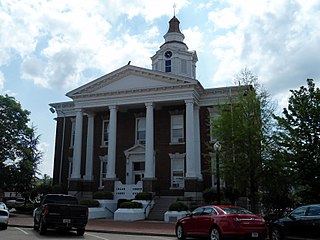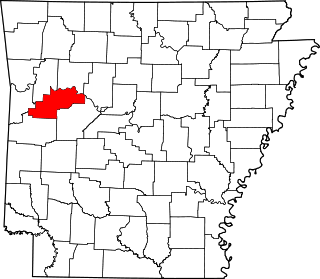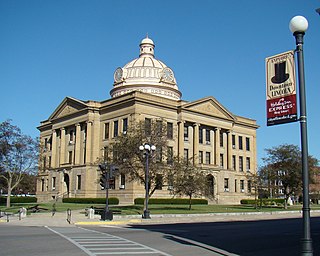
The Lincoln Courthouse Square Historic District is located in Lincoln, Illinois in Logan County. The district is roughly bounded by Sangamon, Pekin, Chicago, Delavan, Broadway, and Pulaski Streets. The district includes 112 buildings, 89 of which are contributing buildings.

The Benton Commercial Historic District is a historic district that was listed on the National Register of Historic Places in 2008. It encompasses the core of the commercial district of Benton, Arkansas, whose major period of development took place between 1902 and 1958. The district's 53 properties reflect the growth and development of the city's businesses. It covers roughly two square blocks, bounded on the west by South Market Street, the north by West Sevier Street, the east by North East Street, and the south by River and East South Streets.
The Monticello Commercial Historic District encompasses a portion of the historic business district of Monticello, the seat of Drew County, Arkansas. The district was listed on the National Register of Historic Places in 2011.

The El Dorado Commercial Historic District encompasses the historic commercial heart of downtown El Dorado, Arkansas. The city serves as the seat of Union County, and experienced a significant boom in growth during the 1920s, after oil was discovered in the area. The business district that grew in this time is anchored by the Union County Courthouse, at the corner of Main and Washington Streets, where the Confederate memorial is also located. The historic district listed on the National Register of Historic Places in 2003 includes the city blocks surrounding the courthouse, as well as several blocks extending east along Main Street and south along Washington Street. Most of the commercial buildings are one and two stories in height and are built of brick. Notable exceptions include the Exchange Bank building, which was, at nine stories, the county's first skyscraper, and the eight-story Murphy Oil building. There are more than forty contributing properties in the district.
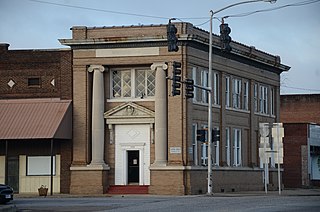
The Prescott Commercial Historic District encompasses the historic commercial core of Prescott, Arkansas, the county seat of Nevada County. Prescott was laid out in 1873, after the railroad was built through the area that is now Nevada County, and the railroad has played a significant role in the city's development. The railroad today bisects the commercial core of the city, which extends for several city blocks away from the railroad. The historic district includes all of the major civic buildings of the city, including the courthouse, post office, and the old Prescott City Jail.

The Magnolia Commercial Historic District encompasses the historic heart of Magnolia, the county seat of Columbia County, Arkansas. It includes the courthouse square and most of the buildings which face it, as well as buildings along Calhoun and Jackson Streets. The centerpiece of the district is the square itself and the Columbia County Courthouse, a Renaissance Revival structure built in 1905 to a design by W. S. Hull. The square is lined with mostly brick-faced buildings built between about 1899 and 1910, and between 1938 and 1958, when the city experienced a second building boom. The oldest known surviving building, then as now housing a pharmacy, is located at 111 S. Court Square. One prominent building from the second building phase is the Cameo Theater Building, an Art Deco design built in 1948.

The DeWitt Commercial Historic District encompasses part of the historic downtown of De Witt, Arkansas, the seat of the southern district of Arkansas County. It consists of roughly six square blocks, focused on Courthouse Square, location of the Southern District Courthouse. This area was platted out when De Witt was established as the new county seat of Arkansas County in 1854, replacing the Arkansas Post, which was not centrally located within the county after numerous other counties had been carved out of its territory. The city's growth remained modest until the arrival of the railroad in the 1890s, and saw most of its civic growth between then and the 1920s. The district includes 54 historically significant buildings, 32 of which face Courthouse Square. The oldest buildings in the district lie just north of Courthouse Square, either facing the square or in North Main or Gibson Streets.

The Marianna Commercial Historic District encompasses the historic civic and commercial heart of Marianna, Arkansas, the county seat of Lee County. The district is focused on two blocks of Main Street and two blocks of Poplar Street, which cross at the northwest corner of Court Square, a city park in which the Gen. Robert E. Lee Monument is found, and extends south to include a few buildings on Liberty Street. The city was founded in 1870, and its economy developed around cotton and lumber, which were delivered to market by the L'Anguille River, a tributary of the Mississippi River. The downtown developed a short distance west of the city's boat landing. Its first brick buildings were built in the 1870s, although the oldest to survive now date to the 1880s, including the elaborate Italianate Hayes & Drake building at 38 South Poplar. Court Square Park has long been a major community meeting point, and is faced by the Lee County Courthouse. The district includes seventy buildings, of which forty eight are historically significant.
The Stuttgart Commercial Historic District encompasses a portion of the commercial center of Stuttgart, Arkansas. The district extends along Main Street between 1st and 6th Streets, and includes a few buildings on the adjacent numbered streets as well as Maple and College Streets, which parallel Main to the west and east, respectively. The majority of the district's 76 buildings were built between about 1900 and 1920, and are brick commercial structures one or two stories in height. Notable among these buildings are the Riceland Hotel, the Standard Ice Company Building, and the county courthouse.
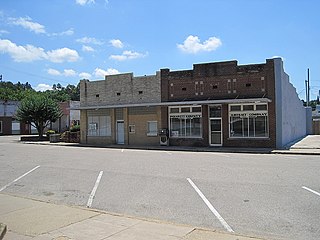
The Harrisburg Commercial Historic District encompasses the historic civic and commercial heart of Harrisburg, Arkansas, the county seat of Poinsett County, located in the far northeastern part of the state. The district encompasses the buildings surrounding Court Square, where the Poinsett County Courthouse is located, and extends a short way north and south on Main and East Streets. Although Harrisburg was founded in 1856, its substantial growth did not begin until after the arrival of the railroad in the 1880s. The oldest building in the district is the Harrisburg State Bank building at 100 North Main. The courthouse is a grand Classical Revival structure built in 1917. Most of the district buildings were built before the Great Depression, using brick or masonry construction.
The Piggott Commercial Historic District encompasses the original center of the city of Piggott, Arkansas, as originally platted out in 1887. It is centered on the square where the Clay County courthouse is located, buildings facing the courthouse square, and also buildings along some of the adjacent streets. In addition to the courthouse, the district includes the c. 1910 railroad depot, city hall, two churches, the 1930s Post Office building, a cotton gin, and a grain storage yard. The town grew because of the railroad, and the plentiful timber in the area, whose harvesting fueled the early economy in the region. The oldest building in the district is the 1897 Clay County Bank at 188 West Main Street.

The Jasper Commercial Historic District encompasses the historic commercial center of Jasper, Arkansas. It includes the Newton County Courthouse, a 1930s Works Progress Administration building, and buildings that line the courthouse square, as well as some of the streets radiating from it. Built between the 1880s and 1940s, the district includes a high quality collection of commercial buildings constructed out of local stone. Most are one or two stories in height, and are vernacular to the period of their construction. Five of the district's 26 buildings were built by Gould Jones, a prominent local blacksmith and mason.
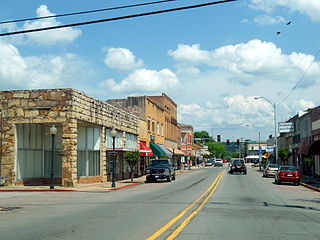
The Ozark Courthouse Square Historic District encompasses the historic late 19th-century center of Ozark, Arkansas. It includes an area two blocks by two blocks in area, bounded on the west by 4th Street, the north by West Commercial Street, the east by 2nd Street, and the south by West Main Street. Most of the buildings in the district were built between about 1890 and 1930, a period of significant growth occasioned by the arrival of the railroad, and are built either out of brick or locally quarried stone. Prominent buildings include the Franklin County Courthouse and the Bristow Hotel.

The Pine Bluff Commercial Historic District encompasses a portion of the historic city center of Pine Bluff, Arkansas. It extends from Barraque Street south along Main Street, extending in places to properties alongside streets. The area's commercial development began about 1840, when the courthouse square was laid out at Barraque and Main, and proceeded through the early 20th century. Most of the commercial properties of the district were built between 1880 and 1910, and are reflective architecturally of late 19th-century commercial building styles.

The Heber Springs Commercial Historic District encompasses the early commercial heart of Heber Springs, Arkansas. The district extends along Main Street, between Broadway and 6th Street, including several buildings along some of the cross streets. The area was developed beginning in 1881, and grew in the late 19th and early 20th centuries, featuring a diversity of commercial architecture from that period. Prominent buildings include the Cleburne County Courthouse (1914) and the Morton Building at 101 South 3rd Street, the city's oldest surviving commercial building (1895).

The Perryville Commercial Historic District encompasses the historic commercial and civic heart of the city of Perryville, Arkansas. It is centered on the courthouse square, where the 1880 Perry County Courthouse stands, as well as buildings facing the square, with a few included on adjacent side streets. This area was developed beginning in the 1840s, when Perryville was founded, and grew through the mid-20th century. Most of the buildings are vernacular commercial buildings, finished in wood, brick, or stone. The most unusual is the Rustic Perryville American Legion Building.
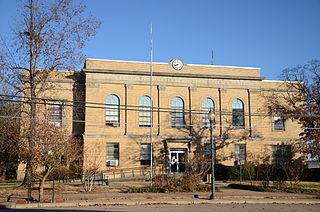
The Logan County Courthouse, Southern Judicial District is located at 366 North Broadway Avenue in Booneville, Arkansas. It is a three-story masonry building, built out of buff brick with limestone trim. It is stylistically in a restrained version of Italian Renaissance styling, with arched windows on the second level separated by pilasters with limestone capitals and bases. It was the second courthouse for the southern district of Logan County, built on the site of the first.

Greenfield Public Square Historic District is a nationally recognized historic district located in Greenfield, Iowa, United States. It was listed on the National Register of Historic Places in 2014. At the time of its nomination the district consisted of 52 resources, including 42 contributing buildings, one contributing site, six noncontributing buildings, and three noncontributing objects. The historic district covers part of the city's central business district in the center of the original town plat. There is a significant number of one- and two-story, brick, commercial buildings, as well as a few three-story structures. The Commercial Italianate style is dominant. While the vast majority of the buildings are commercial buildings, there are four government buildings in the district: the Adair County Courthouse (1892), public library (1916), city hall (1930), and the municipal light plant (1940). Besides the courthouse, the other buildings that are individually listed on the National Register include Warren Opera House Block and Hetherington Block (1896), Adair County Democrat-Adair County Free Press Building (1903), and the Hotel Greenfield (1920).
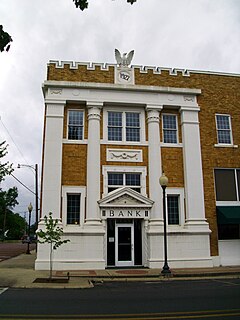
The Warren Commercial Historic District encompasses the historic commercial heart of Warren, Arkansas. The district's northern end is focused on the Bradley County Courthouse and Clerk's Office, and extends down Main Street to Church Street, with branches along cross streets and roads radiating from the courthouse square. This area was developed beginning in the 1840s, but its oldest buildings date to the 1890s, primarily brick commercial buildings. Of architectural note are the courthouse, a Beaux Arts structure built in 1903, and the Classical Revival Warren Bank building (1927).


